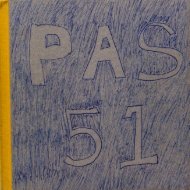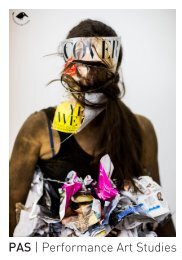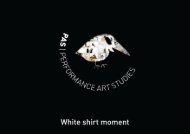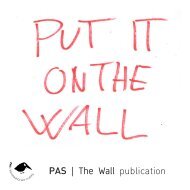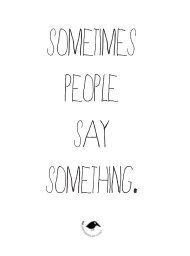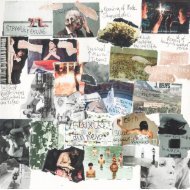Stre!fen
Stre!fen - site-specific performance art project in Görlitz (Germany) and Zgorzelec (Poland) The publication documents the first edition of STRE!FEN in 2020
Stre!fen - site-specific performance art project in Görlitz (Germany) and Zgorzelec (Poland)
The publication documents the first edition of STRE!FEN in 2020
Erfolgreiche ePaper selbst erstellen
Machen Sie aus Ihren PDF Publikationen ein blätterbares Flipbook mit unserer einzigartigen Google optimierten e-Paper Software.
Sarah Schröter
Sebastian Hänel
Sascha Röhricht
Frida Schramm
Jolanda Jansen
Astrid Völker
Jan Treiber
Stefanie Trojan
BBB Johannes Deimling
[…]
The starting point for STRE!FEN were three performances by
regional artists. They were presented on public squares in
Görlitz, such as Berliner Straße or Marienplatz. They took up
all aspects of the stripe by working with stripes, generating
encounters and questions, and exploring spaces and human
behaviours. The performances stimulated conversations with
spectators which were surprised, interested or without comprehension.
[…]
Sebastian Hänel “cleaning the line”
Dressed in a white disposable overall, I walk down the
shopping street of Görlitz with a filled water bucket and a
scrubbing brush. The brush has an extra-long handle, to
which at the end is a parasol attached. I dip the mop into
the water and create a strip of water on the pavement.
Slowly I move forward. I change also sideof the road. I do
not talk, even when I am addressed by people. When the
bucket is empty, I go on the water strip back to the starting
point.
Sascha Röhricht “for and against”
My performance starts with a sound recording by Joseph Beuys with the endless monologue “jajajaja
- nenenenene”, which I heard in excerpts on the radio a few years ago and which has been stuck in my
head ever since. I have played it for some time with the thought to deal with this dialectical NON-SENSes
in an action.
On a sunny Saturday at noon, I become a one-man-demonstration in the well-frequented pedestrian
zone of Görlitz. I carry a cardboard sign - inscribed on two sides with the above-mentioned Beuysian
slogan - and walk slowly up and down the Berliner Straße with it. I seek both eye contact with people
and dialogue with them by silently referring to the words of my sign with hand signals. On one side it
says, “YES YES YES” and on the other side “NE NE NE”. I show people one side of my sign and wait for a
reaction and then suddenly turn my sign and there appears the reversal of the first message. There are
many different encounters and spontaneous reactions.
At the entrance of the trainstation the action ends.
Sarah Schröter “Strips free!”
I start my performance standing on 6 toilet paper rolls. I play with the balance and find very clear and
straight movements in return. I reach the limit of my balanceand fall off the rolls. I take a toilet paper
roll and try to make a path on the cobblestones. I also throw the 2nd roll so there is a 2nd lane on the
ground. The other 4 rolls I use to fix the stripes on the ground which is visible on the cobblestones for
a short time. The toilet paper is blown across the cobblestones by the wind. I try again to draw a stripe
with the toilet paper. Now I move according to it. I use the invisible border in the air and explore the
movement with my body. I use this space and experiment with the white shirt that I am wearing. I move
in the shirt that is slowly falls on the ground. My body follows the movements. I try to pull passers-by
to me by an imaginary thread. I use the toilet paper again and wrap it around my forearms in the air.
I make these circular movements until the toilet paper falls again to the ground. I reach for my white
shirt, wrap it around my right hand and pull my arm up in the air. At the same time, I shout “Stripes
free!” and end my performance on the Marienplatz in Görlitz.
The PAS study group during a conversation about an experiment that was made in the public a few minutes before.
PAS | Performance Art Studies is an independent educational
program that is offering intensive studies to people interested in
performance art since 2008. The aim of the studies is to provide the
participants with a comprehensive form of learning and teaching
in process on performance art. The courses are practical and
theoretical research studies examining performance production,
perception and documentation.
PAS | “THE WALL”
“THE WALL is a documentation and reflection tool, like a notebook, but visible to all participants. It
is an uncensored space where thoughts, statements, feelings, questions, drawings, writings and
images are displayed on the wall throughout the PAS process. Participants can see how the artistic
process unfolds each day and can reflect on how they got to this point.”
“Bike Choreography”, on our way through the cities we were using bikes also to create performative situations.
[…]
Eight interested people from far and near gathered for this week of PAS | Performance Art Studies, led
by BBB Johannes Deimling from August 15-22. Due to Corona-related travel restrictions a lot of interested
people couldn’t come to Görlitz to be part of this site-specific artistic research.
The Artemis Gallery offered their spaces for the meetings, some basic exercises, discussions, and
reflections. But mainly we were outside in the public spaces of Görlitz and Zgorzelec which was very
inspiring because of their structural features and different atmospheres. In addition, the group was on
the road on old GDR bicycles, which we had received from the ‘Radflotte’ of the Kühlhaus Görlitz e.V. and
repaired for STRE!FEN. The bikes were not only the vehicles, but often used for performance exercises
on the way to another spot. Thanks to the permissions of both city councils we could choose our places
freely. Our radius of action ranged from the ruins of the Zgorzelec-Miasto train station to the Polish
and German city parks to the winding and playful alleys and squares of the old town of Görlitz. Plenty of
material for site-specific performances and exercises.
[…]
PAS | “artistic process” - BBB Johannes Deimling
The artistic process of PAS is everything but linear. We think of the artistic process as a circulating and
at the same rotating organism that is open in all possible directions. Everything we do is constantly under
construction and in flux. PAS is interested in how ideas for art works are generated, how concepts
evolve, how the performance situation needs to be prepared and what we need to take care of during
the whole process of artmaking. The PAS studies are well structured and based on experimentation
with a variety of tasks, assignments, exercises, etc. The aim is to provide everyone who is interested in
performance art the full experience and to support their needs at their different stages. Performance
art is a social art form and therefore we believe that a research setting also needs to have a social
context in which the induvial needs or artmaking and the response to others is well balanced. Groupwork,
individual work is changing in each phase of the studies and are used to enhance to widen the
perspective on performance art works, situations and moments. We include the knowledge of other
art forms, such as drawing, painting, sculpture, architecture, poetry, etc. and combine them with the
research work we do. This creates a huge field of inspiration where the participants need to be active
to chose what they want to experience and look
deeper into. The result of a PAS process is not necessarily
a final performance, but more an attitude
and toolbox for further work that resonates a long
time after the studies. In this vivid process everyone
is involved to make the most out of it. Teaching
art means for PAS “let’s find out together”.
Frida Schramm „I like dots more than stripes“
I walk to the fountain (Georgsbrunnen at the Dreifaltisgkeitskirche) with glue dots and a landing
net in my hand. On my head is a transparent plastic bag, which holds my hair together. I
go on the wall of the fountain and start walking along the edge, sticking the dots on my skin.
After my arms and part of my face are covered with the dots, I step off the wall. I stand directly
in front of the wall of the fountain, stretch one arm upwards, take a breath, drop my upper
body forward into the fountain and clap my hand on the water. I bubble as hard as I can into the
water, go up again as soon no air is left in my lungs and repeat the action several times. Then
I go into the fountain and swim laps in it. I always stretch an arm or leg out of the water and
let it disappear again. Afterwards I take water into my mouth, look with my head over the edge
of the pool and let the water out of my mouth. Then I stand up, press my hand against the jet
of water and hold the openings alternately closed. Later I spit at the faces of the figures that
spit out the water. Some glue dots have already come off through the water, the rest, I try to
remove under the water jet. I fish the dots out of the water with the landing net until it’s clean
again. Looking at the audience, I pull the plastic bag from my head, fill it with water and destroy
it. Thereafter I put it on the edge of the fountain and get out.
Sarah Schröter “Nobody”
I collected the red cornelian cherries from and under the tree. Meanwhile I carry a whole lemon
in my mouth. I stopped at the rosebush right away. Four times I look back at the red rose
as I walk along the path to the gate. During this time I also crush the cherries in the red bag.
A part of them came out and fell on the sandy ground halfway down the path. Church bells are
ringing. Arrived at the entrance of the kennel I stopp under the hornbeam.
I take my hands over my head and the cornelian cherry puree ran over and down of it. I go
to the hornbeam and jump up, I hang by my right arm on the tree. Then I slipp and fall down,
squatting down. I wipe my hands on my dress and tried it a second time, hanging from the tree.
I land on my feet and stopp. I go to the step behind me and lay down on the ground. My whole
body is on the ground, my head on the step. I close my eyes. I get up and go into the corner.
There I hide from myself. My body nestle against the walls as much as it could. I try to bite into
the lemon, but I couldn’t do it right away because my jaw hurts. I had to take it out of my mouth
and try several times until I managed. I sit down on the step. I bite painfully into it. I punch several
times on the paint tube next to me. The yellow paint is glowing in my hands and I smear it
on my legs. Afterwards I also stand on my dress. Now I discover a metal chain. It had grown
into the tree and I try to pull it out with all my strength. Let it sound with itself. I did not manage
to pull it out and put it around my neck like a dog collar.
I go to the gate. There I put my feet, hands and arms through it. I close and open the big gate.
Now I climb up and overcome it. On the other side I climb down again. I took it with me and
closed it.
The branches of the ornamental wine graze my face while I go around the corner.
Jolanda Jansen “Bluring Stubborn Borders”
I am standing at the beginning of the bridge crossing the Neisse from Görlitz to Zgorzelec, with
a role of paper, tape and a paper bag with charcoal.
At one foot I have a shoe and at the other foot I have none.
I lay the role of paper down at the beginning of the street crossing the bridge and stick the beginning
of the roll of paper on the street.
I stand on the paper and with my toe I open the roll of paper a bit further and create a white
path.
From the bag I shake some pieces of black charcoal and with my foot with shoe I crush the
charcoal fine. With my shoeless foot I step into the charcoal and take one step further and
leave my trace.
In this same way I go a bit further and further along my path. Behind me the wind fades my
way and my path becomes a difficult road through a piece of land that was changeable in history
within its borders.
When I pass half of the bridge and arrive in Poland, my roll of paper is almost finished and I
roll out the last piece with my hands.
Now I walk to the side of the bridge to my other paper bag that I had put there beforehand.
From there I roll out another paper roll over the railing of the bridge. Exactly on the spot where
the border between Germany and Poland runs.
The line is immediately caught by the wind. Slowly I lower it down, but the line forms graceful
arches, touches the water for a moment and is then taken back into the air by the wind. The
line almost reaches the water acceleration but the wind gets stronger and stronger and suddenly
the paper tears and flies away in a nice arc. Shade!! I hear people say.
Quickly I roll a new piece of paper and create a new line. It quickly gets longer. I grab a bottle
of natural green dye and take a sip and let the dye run down from my mouth over the paper. In
this way the paper becomes the same color green as the water and the trees along the river.
The wind takes a lot of dye and the line is stubborn. The river colors itself greener.
The fight for borders is difficult.
Astrid Völker “salt perishes”
My venue is a sculpture in the form of a salt crystal, which is located in public space, very
close to the river Neisse.
Crouching on the back of the cube, I put on a collar of red glass crystals, then put on black
leather gloves and pulled a white nylon pantyhose over my face.
At an acoustic signal, I began to trace the contours of the sculpture with my gloved hands. I
continued to explore the sculpture not only with my hands but with my whole body, creating as
much contact surface as possible between the sculpture and my hands, arms, legs, torso and
face.
Gradually I climbed the cube, which I explored not only vertically but also horizontally.
As there are many indentations in the sculpture, I followed them and filled in with my body
parts as much as possible all the forms that the sculpture shows. I also stretched up and continued
the lines of the cube in space with arms or legs.
Finally, these movements led me to a standing position. There I opened my arms wide and followed
this movement with my head.
My gesture with outstretched arms towards my sitting colleague caused her to stand up from
the bench and hand me a watering can. Meanwhile I came into a sitting position with legs
stretched out far. The colleague went back to the bench and sat down.
I began to hold the spout of the watering can over my right foot with my legs stretched out far.
Grains of salt trickled out of the watering can. I now let this stream of salt trickle over my right
leg and then over my left leg. Then I let the salt trickle down my arms, my torso and finally my
head and face. The movements were as if I was under a shower.
When the jug was emptied, I placed it on the sculpture and continued my gentle, embracing
movements at and on the sculpture. I descended a little to the front of the cube, to a position
with bent legs that picked up the relief lines of the sculpture. Again I stretched out my arms
wide and threw off first the right glove, then the left one. I continued to slide down the cube,
lifting the stocking mask frontally to the audience and throwing it away. As I looked around, I
smiled slightly.
Finally, I rolled on the floor to my colleague sitting on the bench and stopped at right angles to
her feet in a lying position with my left leg up and my right arm stretched up. We remained in
this picture until the audience applauded.
Jan Treiber “Buchenwald”
Site: Zgorzelec, Bohaterów Getta / Stefana Okreiz
Latitude: 51° 8’59.07”N
Longitude: 15° 0’24.73”E
Date: 21.08.2020
Time: 17:30
The Audience walked on the platform. The Audience waited on the platform. I walked to the
meadow spot. I carried a silver suitcase, 6 rods and a water spray bottle. I placed the silver
suitcase on the meadow. I threw the rods on the meadow. I placed the spray bottle on the
ground at the edge of the meadow, pumped and turned the bottle on permanent spraying, so
that the stoney pavement became wet and darker. This I repeated during my performance
whenever the pressure in the bottle was low until it was empty and all the water spread on the
pavement.
I opened my silver suitcase and put out t-shirt, shorts and a fanny bag and changed my outfit.
I placed my casual dress on the edge of the meadow area. I turned on a timer on a tablet computer
and put it visible in the cover of my silver suitcase. I got a Bluetooth box and a tripod out
of my silver suitcase and placed it in the background of my setting. I turned on a sound collage.
I picked up a big blue water container from out the meadow spot within it. Three tree branches
stuck inside the container (European beech, hornbeam, linden tree). I layed a bag of podding
soil on the ground in the middle of the meadow spot. I spread a golden rescue blanket in the
middle of the meadow on top of the soil bag, got a knive out of the silver suitcase and placed
it on a red towel on the ground. I smoothed out the golden blanket and pricked into it and into
the soil bag beneath with the knive. I put a funnel into the soil bag and poured water out of the
blue water container in it and into the soil bag.Therefore I put the three tree branches on the
ground. The water spread on the ground around the bag. Afterwards I expanded the hole with
my hands and put my feet inside the soil bag. I spread wet soil on the skin of my feet, legs and
arms and stepped out of it again. I then put the tree branches into the bag and tried to fix it in
the soil.
I picked up a rod and fixed the three tree branches to it with black fabric tape. I braced all rods
with the belt of my fanny bag and slang a blue tension belt around my upper body to fix one rod
tight. I then assembled an 8 to 9 meter pole out of the rods. On top of it - the tree branches.
I held the pole and ate one red and one yellow paprika. The
branches and the pole were slightly swaying in the wind. I then
untied the belt and let the pole go down. I put the pole including
the branches on my shoulder and slowly walked down the
platform and out of sight of the audience.
Sebastian Hänel “bodybuilding”
I show the performance in an old dilapidated farm on the outskirts of Zgorzelec.
I am undressed. On my chest I have attached a round mirror. With a thick cord of about
10m length I have tied a roof tile in front of my sex and I am tied with the other end to the
trunk of a big spruce tree. Next to this tree is a small pile of bricks.
At the beginning I am not visible and for 2 minutes I make loud noises inside the house with
big old cutting disks, like scraping, knocking, clinking. Then I throw the largest of the discs
out of the house.
Before I step out of the entrance I pour a lot of water over my whole body. So I cross the
overgrown former yard and walk to the big tree. I lean against its trunk and look at the
audience.
I start to carry bricks in front of the tree. I try to build them on my shoulders, but they fall
down.
The mirror detaches itself from my chest. I take it and look at myself first, then at the
audience. I step in front of the individual spectators with the mirror and hold the mirror up
to their faces.
I carry more bricks in front of the tree and begin to smash them. I install these individual
pieces into the back of my knees. I carry the whole pile of bricks in front of the tree. I smash
more bricks and rub my whole body with one of them.
Now I build a small wall on the ground. On top of it I lie down on the side and with my free
left arm I build more bricks between my legs, between my arm and my upper body, on my
head. I try to keep the bricks in balance. After a short while I tip over sideways onto my
back.
I take the mirror and lay it on my chest. With a brick I hit it and smash it on my body.
I slowly get up and walk in front of the audience as I did at the beginning and hold the
broken mirror in front of the individual spectators, breaking it further. I attach the two parts
to a hanging branch of a spruce tree.
I loosen the string on the roof tile and start to turn around myself, dancing slightly. I pick up
a small bicycle bell from the ground, with which I create a bell sound with each rotation. The
unwinding string leaves me more and more free until I disappear behind the house and the
roof tile falls off me.
Stefanie Trojan “Grenzwärtig” (limit)
I am standing on the bridge between Görlitz and Zgorzelec. My position is marked through a
taped square on the street. My goal is to get people into the square. Therefore, I point on passersby
and afterward on the square. If I manage to get someone into the square, I mark another
square until I will create a border made by humans.
The performance becomes independent, because of the involved people starting to point themselves
on others to get them into the squares to replace themselves. So the border gets fluent,
alive, vivid, stable and instable.
This is a boarder made by humans. They are on 1,5m distance. To go through this border you
can`t hold this distance. Some people turn around, blocked by the lively boarder. The borderline
between Poland and Germany gets visible and perceptible. A limit that is not seen anymore in
the daily life of the inhabitants, but sometimes appears in their brains. This boarder was a topic
while travel restrictions during covid 19 sanctions and is perceptible in the manifesto of right
wing politics.
BBB Johannes Deimling “It ain’t over until it’s over #3”
It is a hot August day. The performance takes place in a public park in front of the backdrop
of the old capacitor factory in Görlitz, close to the border river Neiße (Nysa Łużycka) between
Germany and Poland. Within this beautiful setting two white, wooden chairs are standing opposite
to each other; on each chair, an old book is laying in which colored feathers are placed; 25
big, orange paper boats are grouped with attached strings; a white, wooden ladder is leaning at
a birch tree; a big yellow pointed hat is standing close to a fence beside a bundle of silver cans.
I am wearing a white shirt, a white trouser. My head, hands, and feet are painted white. I walk
slowly around the performance setting. After a moment I sit down on one chair.
I create a performance collage of images by doing the following actions:
Burning the pages of the books and flipping the pages [pages turn into ashes]; waggle colored
feathers over the burning pages [smoke distributes in the air]; putting blue paint on my fingers
and place them on my mouth and start talking “ble, ble, ble, ble, …” while moving my blue fingers
up and down between mouth and chest [a blue lung appears on the white shirt]; climbing
the free standing, wooden ladder [constantly balancing and falling]; throwing the ladder as high
as possible in the air until it is crashed [with each throw the ladder bursts into more pieces];
putting the yellow pointed hat on my head, making 4 different body postures, each time shaking
the silver cans [loud sound of clinging silver cans]; placing the yellow hat as a beak in front of
my face, hitting it on ground [the yellow beak deforms with each hit], binding the books with
a string under my feet, walk to the boats and pull them behind me to the river; drowning the
orange paper boats in the water [each boat goes down with a splash], carrying the wet orange
paper back to the chairs [leaving a trace of dripping water on the ground]; sit down on one
chair, light up a blue and a yellow smoke torch [yellow and blue smoke distributes in the air
and mixes into green]; place the wet paper on my head, wait a moment [dripping water, green
smoke]; wave with two white cloths while walking backwards away from the action scene.
Note: besides the invited audience, people who were having a walk in the park stopped and
watched the performance. During the performance two children were constantly talking in Polish.
After the performance I got to know that they were commenting on each action I did. A pity
that this conversation is not documented.
[…]
The opening of the exhibition of the whole project Stre!fen took place in the Artemis
gallery in Görlitz. At the opening Sarah Schröter presented her performance “I carry it
too”. After the performance the exhibition was opened with speeches by Sebastian Hänel
talking about the Stre!fen project and BBB Johannes Deimling talking about the PAS | Performance
Studies week.
[...]
[...]
Pictures from all performances as well as from the study process were shown. Selected performance
objects and a video documenting the final performances of the PAS study week collected the outcome
of the artistic results of the project. The special feature of the exhibition was fed by the lack of
large-format photos, which were lost in the mail and made the design of the exhibition a real challenge.
The visitors were greeted by empty picture frames on the wall (all personalized and titled). Under a big
white cloth were smaller images of the performances and the process hidden and revealed after the
opening speech. The visitors could see a variety of pictures and got in direct conversation at the table,
by commenting, asking questions and listening.
[...]
[...]
The exhibition showed the richness of this project and its potential. The overall opinion from artists and
as well visitors: This project should continue and grow.
[.]
STRE!FEN is a project of Wildwuchs e.V.
c/o Jana Lübeck, Sechsstädteplatz 3, 02826 Görlitz (www.derwildwuchs.de)
in cooperation with Artemision e.V., Centre for art, Handwerk 13, 02826 Görlitz
STRE!FEN is sponsored by
Gefördert durch die Stadt Görlitz
and Kulturstiftung des Freistaates Sachsen
Cooperation partners and supporters
Stadtverwaltung Görlitz - Straßenverkehrsamt
Stadtverwaltung Zgorzelec - Abteilung für Förderung und internationale Zusammenarbeit
PAS | Performance Art Studies, Monika Deimling & BBB Johannes Deimling
(pas.bbbjohannesdeimling.de)
Atremission e. V. Görlitz, Carmen Neumann
Kühlhaus Görlitz e. V.- Radflotte
Sebastian Schwalbe - Instandsetzung der Fahrräder
A special thanks to all who made this project possible!
Layout
BBB Johannes Deimling
Photographs
Monika Deimling: cover and backcover, page 1, 3, 4, 8, 9, 11, 14, 15, 16, 17, 18, 19, 20, 21, 22, 23, 25,
26, 29, 30, 31, 32, 33, 35, 36, 37, 38, 39, 40, 41, 42, 43
Sascha Röhricht: page 5, 7
Sebastian Hänel: page 6
“In the midst of the restrictions imposed by the
Corona crisis, STRE!FEN sent an important signal
regarding the viability of art projects.”










